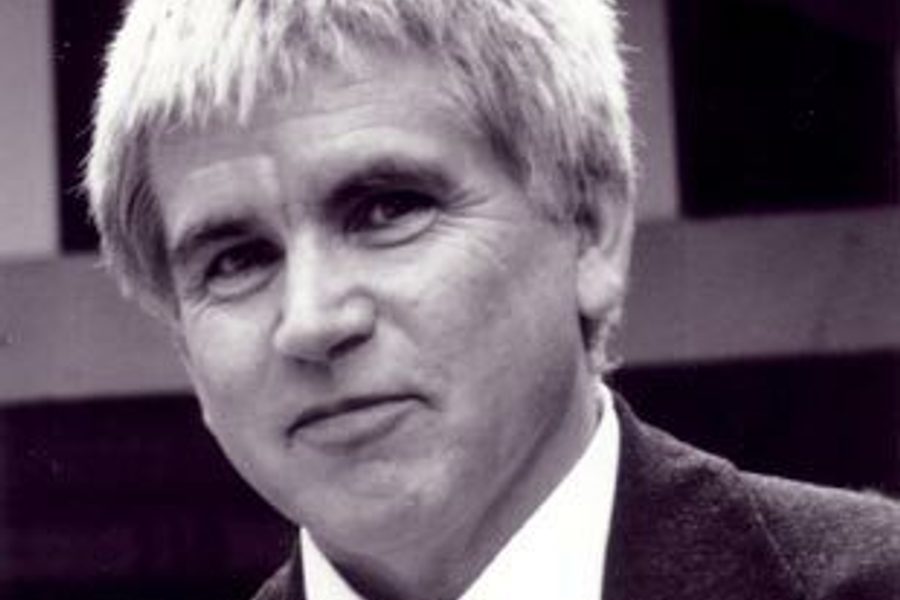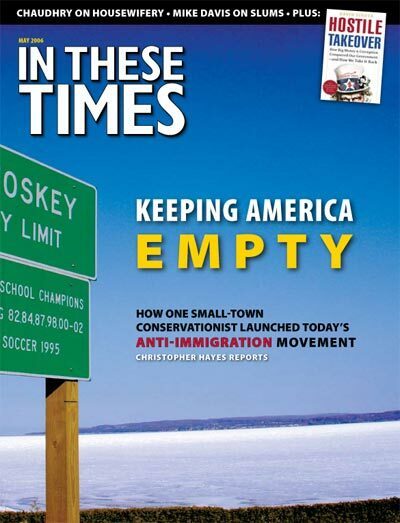
It’s tempting to call Mike Davis, a history professor at University of California at Irvine, a modern-day seer. One of his first books, City of Quartz, published in 1991, essentially predicted the L.A. riots, along with other, less dramatic phenomena of the ’90s, such as the exploding prison population and the rise of gated communities. “Poor, Black and Left Behind,” a 2004 article he wrote for TomDispatch.com after Hurricane Ivan narrowly missed New Orleans, reads eerily prescient in the aftermath of Hurricane Katrina. Seeing as the United States has done little to address the concerns he laid out in his last book, The Monster at Our Door, about an avian flu epidemic, we can only hope that, this time, he’s wrong.
But Davis isn’t some divine prophet. He’s simply an incredibly astute observer, whose analyses of the natural (and artificial) world factor in race, class, geography, ecology, history, economics, politics, literature and any other discipline that might lead to new insights.
In his most recent book, Planet of Slums, Davis applies this polymathic approach to the exponential increase in the number of slum dwellers in the Global South during the latter half of the 20th century. In These Times recently spoke to him about the book.
What compelled you to write the book?
The book is a response to the truly epochal report of the United Nations, “The Challenge of Slums,” that came out three years ago. Before this report there simply wasn’t the data or even the methodology to look at the condition of the urban poor worldwide. It’s an enormously ambitious and important study, and I wrote an essay in response to it. The book is an expansion of that, a kind of armchair exploration of a rather vast literature about the urban poor. I focus particularly on what are really the key questions: Is there still enough free or cheap land to sustain informal urbanization? Is there still enough economic opportunity in the informal sector – the main employer of new immigrants of the poor in the major Third World cities – to sustain the role of the informal sector? I think the answer to both is that we’ve come to a closing frontier of opportunity, and the book explores the consequences of that.
How many people are living in slums today?
Two years ago, the head of U.N. HABITAT [the United Nations Human Settlement Program] estimated that 1 billion people were living in slums, classically conceived as having inadequate, substandard housing and missing some essential services. A much larger number, perhaps 2 billion people, live in cities and are poor.
More than a billion people, again overlapping with slum dwellers, really exist outside the formal economy and formal employment. These developments are gigantic, and in some ways unexpected. No social theory predicted that urbanization would take this course at the end of the 20th century or on such a vast scale.
How do the slums today in the Global South differ from the 19th century slums?
The slums in St. Giles in London and in Old Town Manchester that Friedrich Engels explored in his pioneering report, “The Condition of the Working Class in England in 1844,” were slums in the shadows of factories. The residents were factory workers or industrial workers. Most of the slums of today’s world resemble Naples or Dublin in the 19th century – cities that grew by absorbing poor people pushed out of the countryside or who were made redundant in traditional handicraft jobs by the industrial revolution. These cities were manifestly not industrial cities. If Europe had not had the safety valve of immigration to the New World for tens of millions of people, undoubtedly you would have seen more Dublins, more Naples.
So while it would be easy to find cases where slum dwellers work in some sweatshop – making something for Wal-Mart or another multinational – slum dwelling now goes hand-in-hand with informal employment. Industrialization, except in southern China and parts of East Asia, doesn’t drive city growth. Instead, there’s this phenomenon of cities growing at extraordinary speeds in African countries where formal economies are shrinking or in depression. This shows that the forces pushing people into the cities, pushing them out of the countryside, are more powerful than the forces pulling them into the cities – i.e., formal urban employment.
What are the forces pushing people into the cities?
Slums grew most rapidly beginning in the late ’70s and continuing through the ’80s. It was the period of debt and debt-adjustment, and the cities started to grow because these policies had the most dramatic impacts on rural employment. But while these cities grew rapidly, urban investment – at least on a per capita basis – was declining dramatically under the so-called “structural adjustment programs” administered by the World Bank. The price for countries wanting to stay in the world economy was to restrict public spending and in some cases to literally dismantle public sectors precisely when that investment was most urgently needed to meet the demands of population growth. So the question then is: How did cities actually grow if there was no public investment, no new infrastructure?
The answer: People bootstrapped urbanization through building shanties and their own infrastructures, eking out employment as domestics or street vendors or laborers. So, people begin to celebrate this miracle of informality, of informal housing and informal employment. But the literature clearly shows that that moment has now passed. There always will be exceptions, but there are far more slum communities in which new arrivals and the children of previous slum dwellers find themselves worse off, without access to free or cheap land, faced with tremendous overcrowding in these survival niches of informal employment.
This is particularly true for what researchers call the “peri-urban” slums. About a third of the slum dwellers in the Third World live in traditional inner cities, but most live on the peripheral edge in peri-urban slums: sprawling, endless slum-suburbs. They have become one of the most important sites in world politics, because it’s the social reality we know least about, where the city meets the countryside in a hybrid and unprecedented form.
At the same time as the explosion of this peri-urban slum area, there is also a parallel growth of what you call “off-worlds.” Can you explain the term?
Sure. Off-worlds come about from the flight of the global urban middle-classes into often fantasy-themed, gated housing projects and suburbs – self-contained realities. It is a measure of the failure of urban integration and urban reform, driven not just by pure crime or disorder, but as a way to kind of consolidate scarce resources for infrastructure. What you find are middle-classes connected to global cyberspace, living almost American or California-type lifestyles, whereas the rest of the city is often cut off from modernity, without any of the essential infrastructures. This is a strikingly universal phenomenon in Latin America, East and South Asia and the few countries in sub-Saharan Africa that have big enough middle classes. Of course, this is rapidly increasing the existential and social distance between classes within the city.
What’s striking about it is the uniformity of these off-worlds. Whether you’re talking about Jakarta or a nouveau-riche suburb of Beijing or a suburb of Cape Town or Cairo or a development outside of Buenos Aires, they all tend to be fantasy theme parks of California lifestyles, and some of them are indeed modeled in detail after TV versions of California reality. So you have several of these communities actually called “Orange County,” you have Disneyland-themed suburbs. It’s a rather extraordinary phenomenon.
I’d like to go back to the structural adjustment programs, and describe how they affected this growing urban population.
Well, first of all, in the ’70s when developing countries were induced by every means possible to take on large burdens of debt, most of the loan money was designed to be invested in export sectors in agriculture. In other words, it was used to convert traditional agriculture to export agriculture, to increase the supply of raw materials, particularly for countries like Japan. Then the crunch came at the end of the ’70s. Raw material prices and export prices fell to almost historic lows, reducing these countries’ incomes. The IMF stepped in to take over the administration of really nasty short term adjusted countries, but the World Bank – which had emerged out of the reconstruction of Europe – took on the newly appointed role of managing the medium and long-term adjustment of countries.
Almost everywhere this meant slashing public employment and reducing public expenditure, often reducing the footprint of city government. It also meant policies that eliminated protected industries, like manufacturing for the home market. This had devastating impact, first of all on formal employment in cities of the Third World. But it had these longer-term devastating impacts because of the shortfall of urban investment vis-a-vis population growth. For instance, many of the countries of East Africa suffered a massive flight of medical personnel in the ’80s. Just before AIDS popped up on the horizons, nurses and doctors were leaving countries like Zimbabwe or Kenya because of the structural adjustment programs’ downsizing of public health expenditures. At the same time, more people than ever were moving into cities, and in the case of Kenya, almost all population growth over the last generation has been accommodated in urban slums.
So the ’80s was a pivotal decade in the history of world urbanization, and it’s in this decade that investment and formal employment growth became so radically disconnected. The state disappeared from the scene in terms of providing housing or ensuring employment. In some cases this has reached nightmarish extents, the limit case being Kinshasa in the Congo, where 95 percent of the economy is informal.
You write about the witches of Kinshasa…
Only because they’re a symptom of what happens at the very limits of economic informalism – this paradigm that expects that the poor can somehow always heroically and creatively invent solutions for their own dilemmas. In a society where people deeply love children and the family nexus is everything, families in Kinshasa are now stretched to the utter breaking point, so children are cast into the street as witches. It’s basically a socially acceptable formula for the abandonment of children. Most of the people who write about it see it as a symptom of the extremity of the human situation in Kinshasa.
You note that the “deep thinkers” at the big think tanks have yet to grasp the geo-political implications of this exploding slum population.
That’s because they think too deeply in traditional paradigms. But the more empirical thinkers in the United States – the Armed Forces war planners – are very much on top of this. A large literature exists on the level of Pentagon war planning and strategic thinking. It’s very focused and precisely formulated. They’ve grasped that the biggest dilemma for America is control and domination of these peri-urban areas. The United States can dominate any urban system that’s hierarchical and centrally organized: We can surgically take out all the crucial nodes. But what do you do when faced with an invertebrate organization of sprawling slum-peripheries? Even the indigenous administrations of these cities know very little of what goes on in the labyrinth of these shantytowns.
Surely the Pentagon’s concern also stems from the fact that the poor are automatically equated with criminals.
Of course. And it also comes out of empirical experience. First, Mogadishu in 1993 revealed that within the labyrinth of the Third World city, American military superiority rapidly began to break down. And then, in Iraq, unexpectedly, the occupation had to deal with this problem in Sadr City and Fallujah. From these empirical adaptations then begin to come generalizations, which usually take the form that in the future we can expect to find this miscellanea of different criminal and fanatical groups.
In other words, the military doesn’t believe that there’s a single enemy – al Qaeda or something like that. They believe that there’s a single terrain that affords a huge variety of potential foes with strategic and tactical advantages, and that the chief aim of American military planning must be to find a way to overwhelm them with technology. This means first acquiring knowledge of these terrains, which we know most about from aerial and satellite photographs. This is how people study peri-urban slums these days.
Can you talk about the sequel you’re co-writing with Forrest Hylton about the resistance within these slums?
Originally, I wanted to look at the diversity of what I call “governments of the poor” that have emerged in the last generation. It’s impossible to begin with generalizations about the urban poor; you need to start with case studies and see where that goes. Poor urban dwellers are experimenting with every possible kind of solution to their plight, from the Holy Ghost to ethnic militias, from traditional radical politics to millenarian cults. We have a new historical category of people here. To what extent they have the capacity of “historical agency” – that classical radical social theory attributed to the working class – remains to be seen.
My own hunch is that a lot of what is taken fundamentally as the “clash of civilizations” is actually transitional in form. Obviously, religious fundamentalism has taken hold with such force – in the Middle East and North Africa particularly – because of the destruction and decline of traditional Arab law. But I don’t see any reason to believe that the hegemony of fundamentalism is necessarily an eternal one. There may be a lot more fluidity here than there appears.
However, there is a very interesting contrast between the Arab world and Latin America. In the big cities of the Arab world, the religious middle classes – particularly the professional middle classes like doctors, lawyers and engineers – are deeply involved in the lives of the poor through Muslim Brotherhood-dominated professional organizations. They’re involved in the life of the slums, providing services that the state fails to provide. This creates a wealth of connections between the fundamentalist middle classes and the poor. It’s completely different from Latin America.
What’s always scary about Latin America is that any serious radicalization always leads to huge confrontations of class against class, with the middle class solidly lined up on the side of the rich. It’s striking to me that in Caracas, Chavez had to bring in Cuban doctors because so few Venezuelan doctors were willing to volunteer for his outreach program in the slums. Whereas in Cairo and other Muslim cities, one of the most effective ways the Muslim Brotherhood is able to organize is by taking over the professional association of doctors – with the doctors going into the slums, running clinics, creating this dual power. This creates a parallel society that can then de-legitimize and confront the corruption of the state.
In other words, in comparing situations of the urban poor across the world, you need to take into account the totality of social relations and class relations in cities that can differ greatly. And of course, I’m not discounting that anyone can find hundreds of upwardly mobile slums in the world. But having digested a rather huge body of literature over the last year or two, the unanimity of findings among researchers in such different places on every continent are strikingly uniform: the materials, the resources, and the potential for bootstrapping and self-help solutions are diminishing. And they’re diminishing everywhere.








